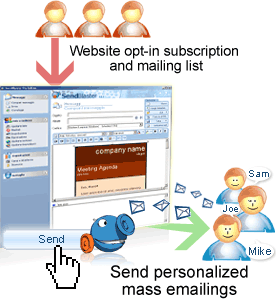Various form of communication on the internet
1) E-Mailing
- A system for sending and receiving messages electronically over a computer network, as between personal computers.
- A message or messages sent or received by such a system.
- E-Mail is a method of exchanging digital messages from an author to one or more recipients.
- Modern email operates across the Internet or other computer networks. Some early email systems required that the author and the recipient both be online at the same time, in common with instant messaging.
- Today's email systems are based on a store-and-forward model. Email servers accept, forward, deliver and store messages. Neither the users nor their computers are required to be online simultaneously; they need connect only briefly, typically to an email server, for as long as it takes to send or receive messages.
2) Chatting
- Internet chatting involves real-time instant text messaging between two or more users in chat rooms. They are many different types of Internet chats all with different purposes.
- Internet chatting has its advantages and disadvantages; therefore it is important to understand them so that you do not fall victim to predators who would seek to harm you.
- Once a chat has been initiated, either user can enter text by typing on the keyboard and the entered text will appear on the other user's monitor. Most networks and online services offer a chat feature. Example IRC and facebook.
- Internet chat rooms allow you to communicate with different kinds of people from all over the world. They allow you to meet different kinds of people who share similar interests, goals, hobbies and desires.
- Internet chats can also be a great learning center ( e.g. chatting forums) where people can ask questions and receive answers on products and services, computer troubleshooting and more.
3) Video Conference
- A videoconference or video conference (also known as a videoteleconference) is a set of interactive telecommunication technologies which allow two or more locations to interact via two-way video and audio transmissions simultaneously. It has also been called 'visual collaboration' and is a type of groupware.
-Videoconferencing differs from videophone calls in that it's designed to serve a conference rather than individuals. It is an intermediate form of videotelephony, first deployed commercially by AT&T during the early 1970s using their Picturephone technology.
4) Net Meeting
- A product developed by Microsoft Corporation that enables groups to teleconference using the Internet as the transmission medium.
- NetMeeting was bundled as part of Windows and included point-to-point telephony and video calling capability over the Internet as well as multipoint whiteboard and application sharing.
- NetMeeting supports VoIP, chat sessions, a whiteboard, and application sharing. It's built into Microsoft's Internet Explorer Web browser.
- The advent of instant messaging (IM) and other alternatives for online, real-time communication contributed to its demise. Microsoft announced a replacement online meeting service called Office Live Meeting, formerly from PlaceWare, a company Microsoft acquired in 2003.
5) Newsgroup
- A newsgroup is a discussion about a particular subject consisting of notes written to a central Internet site and redistributed through Usenet, a worldwide network of news discussion groups. Usenet uses the Network News Transfer Protocol (NNTP).
- Newsgroups are organized into subject hierarchies, with the first few letters of the newsgroup.
- Discussion group on the Internet as well as a source for MP3 files and images.
- Newsgroups make up the Usenet (user network), which preceded the Web by more than a decade.
- Starting in the late 1970s, newsgroups were message boards for Unix technical issues. However, they continue to prosper alongside Web-based discussion groups called "forums" (see Internet forum).
- Although a topic can be newsworthy, newsgroups have nothing to do with the daily news. Organized into categories, alt (alternative) contains the most diversity (see newsgroup categories).
6) Forum
- An Internet forum, or message board, is an online discussion site where people can hold conversations in the form of posted messages. The forum is the place for people to virtually meet online where they can post messages and respond to each other. These usually are set up to discuss a specific topic (ie. children, computing, HTML).
- They differ from chat rooms in that messages are at least temporarily archived. Also, depending on the access level of a user or the forum set-up, a posted message might need to be approved by a moderator before it becomes visible.
- Forums have a specific set of jargon associated with them; e.g. a single conversation is called a "thread."
- A forum is hierarchical or tree-like in structure: a forum can contain a number of subforums, each of which may have several topics. Within a forum's topic, each new discussion started is called a thread, and can be replied to by as many people as wish to.
- Depending on the forum's settings, users can be anonymous or have to register with the forum and then subsequently log in in order to post messages. On most forums, users do not have to log in to read existing messages.
Peripherals used for communication are :
1) Web Camera
2) Microphone
3) Earphone


























1 comments:
Online discussions can be greatly beneficial to student learning and are often one of the first things lecturers consider when moving elements of their courses and modules online as part of a blanded learning strategy.
Advantages of Internet Communication
Post a Comment